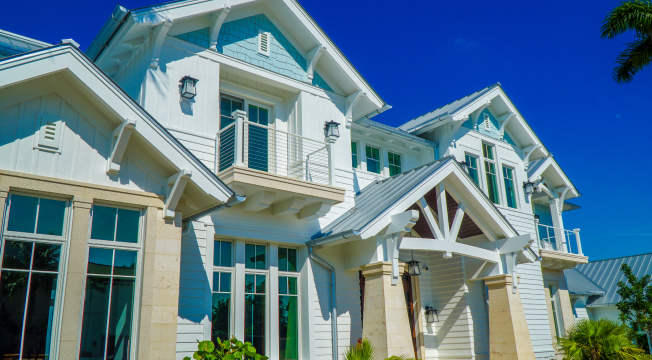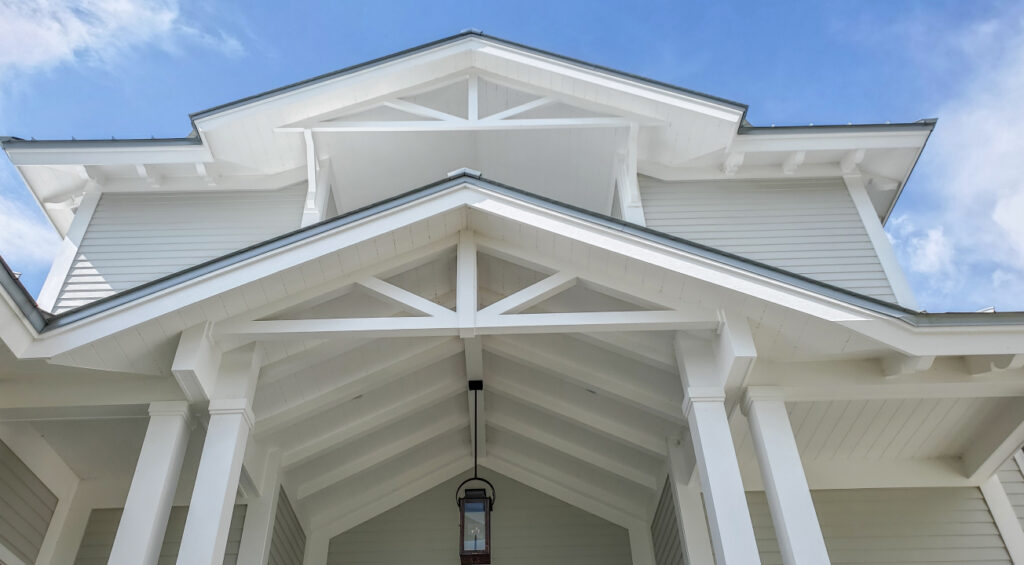The parts of a house exterior are just as important as the interior when creating an inviting atmosphere that you and your guests can enjoy. Understanding your home’s exterior components is crucial for creating an inviting atmosphere. This blog explores the anatomy of a house exterior, explaining the purposes of features like siding, fascias, aprons, and dormers, and how they enhance your home’s curb appeal.
Why is it Important to Know About the Common Parts of a House’s Exterior?
Whenever you’re looking to redecorate your home’s exterior, knowing the names and functions of the different parts of a house exterior makes everything much easier. You can also easily maintain your property and estimate repair and replacement costs if you understand how each part looks and functions.
The Parts of a House’s Exterior
There are many parts of a house’s exterior for you to learn, from the drip edge to the soffit. Understanding which parts of a house exterior perform which functions makes you a more responsible and well-informed homeowner. Check out this thorough overview of the external parts of a house
A. Structure of a Roof
Your roof is made up of numerous sections that impact the structural integrity and lifespan of your home as a building. Read on to go into more depth about the structure of a roof.
- l. Roof Primary Structure
- Starting from the top down, let’s look at the roof first. You can find several features in most roofs, regardless of your home’s architectural style.
- 1.Chimney
- Perhaps the most well-known part of your house’s exterior is the chimney. Typically made from bricks, metal, or concrete, chimneys vent smoke and gasses from fireplaces in your home, protecting indoor air quality by removing potentially harmful substances.
- 2.Roof Hip
- Roof hips are common in residential homes, forming where sloped roof sides meet, typically at 90-degree angles. They enhance structural stability and efficiently shed rain and snow along the roof line, preventing water damage.
- 3.Roof Gable
- A roof gable, the triangular wall section on a house’s exterior at the roof’s peak, is a common and practical architectural feature. A gable roof also helps with attic ventilation to the house exterior, preventing issues like mold and overheating.
- 4.Gable Vent
- Roof vents are common parts of gables. They are essential for maintaining your house’s exterior by promoting air circulation and preventing issues like wood rot and mold. They come in various shapes and sizes, which allows you to choose the right one for your home’s needs.
- 5.Box End
- The box end is the enclosed section of your roof’s overhang, providing a finished and secure appearance to your roof’s edge. It shields your roof from the elements, giving your home a clean and polished look, similar to decorative trim on the sides of your roof.
- 6.Drip Edge
- Your roof’s drip edge sits under the shingles and directs water away from your home’s fascia and siding. Usually, a drip edge uses plastic or metal in an L-shape up to the roof line. The metal strip edge protects your house’s exterior parts from water damage.
- 7.Soffit
- Soffits exist beneath your roof’s overhang. They connect the roofline to your home’s walls, providing ventilation and maintaining temperature and moisture levels. The soffit also enhances your home’s appearance by concealing less appealing structural elements.
- 8.Fascia
- Fascias, located at the lower edge of your roof and facing outward, conceal rafters from weathering and offer structural support for gutters. Regular inspection of fascias ensures proper property maintenance. Fascias also help your home look neat and stylish.
- 9.Eave
- Eaves extend beyond your walls to the roof edge to shield your home from the weather. They distribute your roof’s weight across the width of your house to increase stability. Eaves are available in closed styles, with soffits, or open styles, offering various aesthetics to your house exterior.
- 10.Rake
- The roof’s rake, forming a triangular shape along the gable end, safeguards your home from the weather by shielding roofing materials from wind and debris. They also add aesthetic appeal to your home’s exterior.
- 11.Roof Shingles
- Roof shingles, typically flat and rectangular, shield your home from elements like UV rays, snow, rain, and heat. They’re made of asphalt, wood, slate, or metal, overlapping in rows to form the roof’s protective layer.
- II. Roof Vents
- Beyond the shape and size of your roof, roof vents are another common aspect of a house exterior. There are different styles of roof vents, so you’ll benefit from learning which kind is on your home.
- 1. Roof Vent
- Roof vents are usually found near the surface of the roof. They release hot air and humidity from the attic to regulate temperature and moisture. Maintaining a roof vent can extend your roof’s lifespan and keep your house from molding.
- 2. Ridge Vent
- The ridge vent serves the same purpose as the average roof vent but is for a specific type of roofing. Ridge vents are found near or on the ridgeline of your roof, sitting above it to ventilate air.
- 3. Gable Vent
- A gable vent differs from roof vents and ridge vents because it’s found on the gable end of your home. It serves the same function of removing moisture and hot air from the attic areas of your house to improve circulation.
- III. Roof Gutter System
- 1. Gutter
- Your roof’s gutter is a trough that runs along the eaves of your roof line to collect rainwater and move it away from your property. Gutters prevent water damage using a system of end caps and downspouts.
- 2. End Caps
- The end caps of your gutter system are protective components that seal the ends of the guttering. Using end caps keeps debris from getting clogged in your gutters and lets the water flow properly to the downspouts.
- 3. Downspouts
- Finally, the downspouts of your guttering are vertical pipes that accept the rainwater from the gutters and lead it away from your home’s foundations. Without downspouts, rainwater can erode the earth around your home.
B. Sides of a Home
Once you’ve progressed past your home’s roof, the walls and other side features are next. Connecting your roof to your house involves many features. Let’s review what you should know.
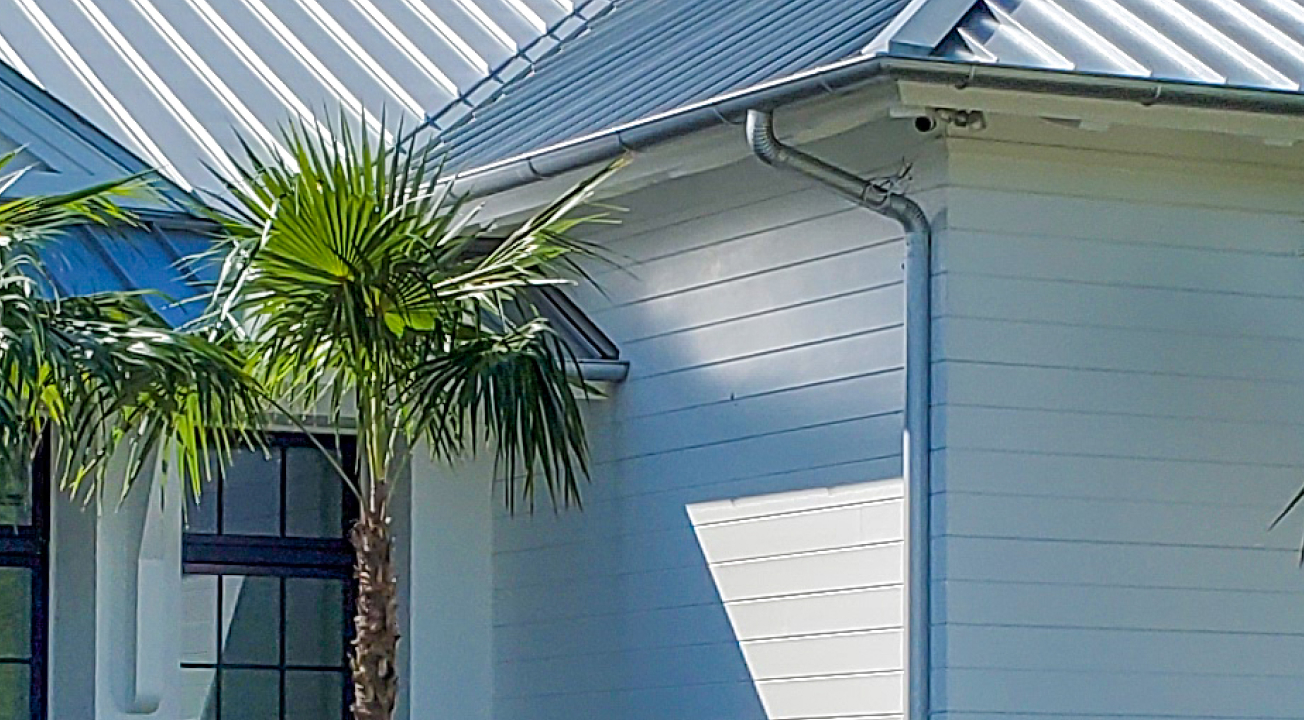
- I. Edges and Ends
- Firstly, you should know the ins and outs of protecting your home’s bones from the elements. Look at the aesthetic features that make your house a secure building that withstands rain, wind, and snow.
- 1. Frieze Board
- A frieze board is a decorative trim that connects the eaves of your roof to your exterior wall. It improves the overall appearance of the house exterior and protects some of the overhang structure from weathering.
- 2. Siding
- Siding is one of the parts of a house exterior we all know. It’s a covering that’s common in residential buildings, protecting your home’s structure from weather. High-quality siding material includes metal, cement, and vinyl siding.
- 3. Corner Posts
- Craftsman, Cape Cod, and Victorian-style houses often have corner posts around the house exterior. A corner post adds strength to the structure and adds to your home’s aesthetic.
- 4. Foundation
- The foundation is possibly the most important part of a house exterior—all the other parts rest on the foundation. Usually, foundations are made of concrete or stone to support the weight of the different parts of a house.
- 5. Sidewalks
- Sidewalks allow pedestrian access to your home, typically leading to your front door or garage doors. Aesthetically designed sidewalks and pavers make your outdoor space look inviting for family and friends.
- 6. Wall Corner Studs
- Wall corner studs create a framework that supports your home’s structure in weaker corner areas. They also provide a foundation for attaching siding to your exterior walls. Maintaining your wall’s corner studs helps your house withstand seismic activity and extreme winds.
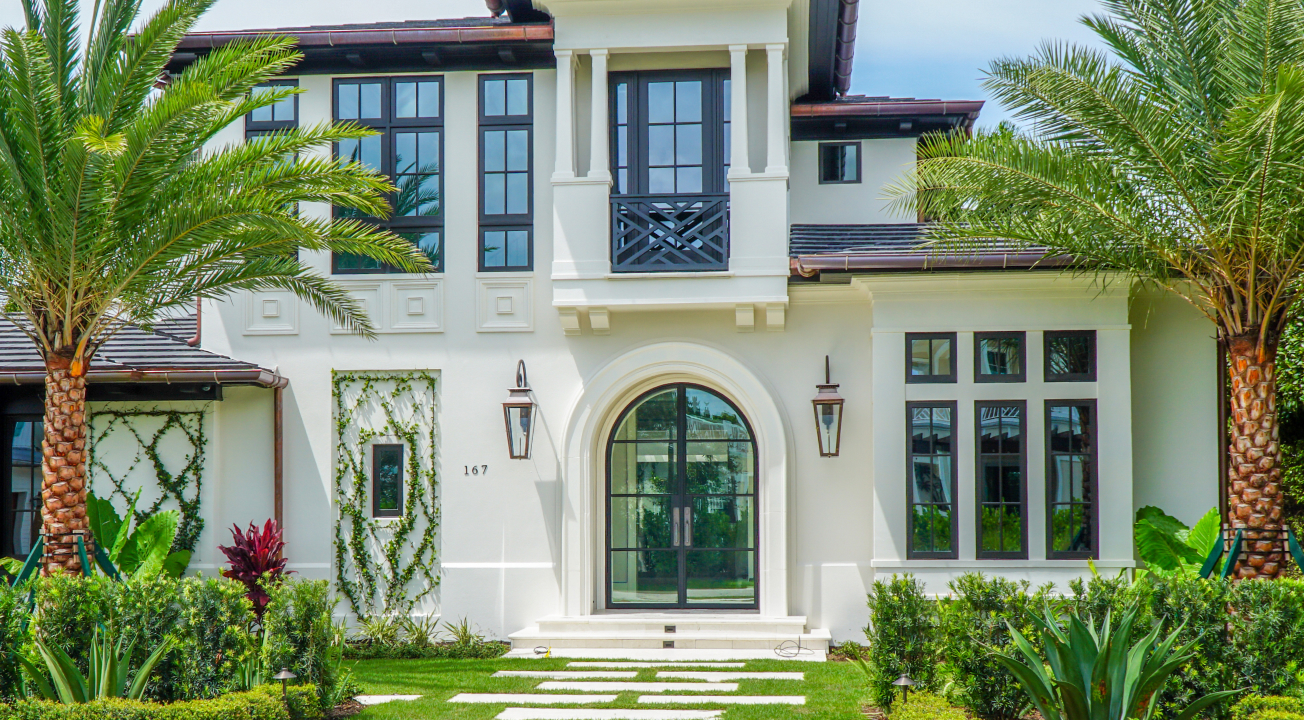
- II. Doors and Windows
- Doors and windows are parts of a house’s exterior that are more complex than you might first think. You should examine the various external features of these aspects of your home.
- 1. Grid/Grille
- Grids-or grilles-are decorative patterns on the exterior of your window frames or doors. Often, grids use vinyl or wooden materials to create patterns that add to the visual appeal of your home, breaking up the natural light that gets inside. They also add some structural support.
- 2. Trim
- The trim on your windows and doors is a protective molding that seals gaps between these features and your walls, keeping fresh air out and making your home more energy efficient. You can have trim installed in various materials, including wood, vinyl, and metal, to achieve different finishes.
- 3. Headers
- Window and door headers are parts of a house exterior that add a finishing touch and create strength in your home. Headers are horizontal components made from wood, steel, stone, or other load-bearing materials that distribute weight above an opening like your front door.
- 4. Apron
- The apron of a window is a decorative trim molding that goes beneath the windowsill. Your home’s exterior features look cohesive and polished with window aprons. They also direct water away from the interior of your house.
c. Front of a House
The front of your house exterior is paramount to its curb appeal. Here’s a breakdown of the common features found in the front of a house.
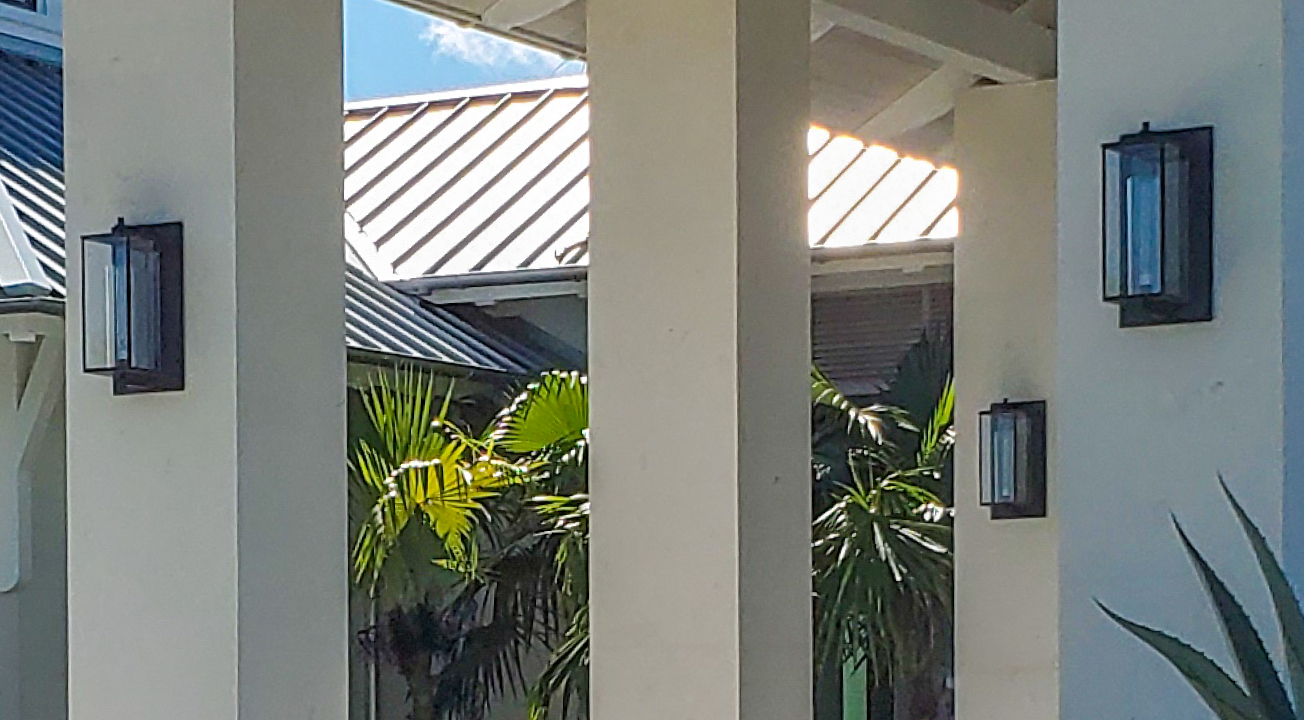
- 1. Porch
- The porch is a platform with a roof covering that extends from an entrance of the building to create a space between the indoors and outdoors. There are numerous ways to design a porch to suit your home’s style, including screened-in and wrap-around porches.
- 2. Steps
- Not every home has external steps, but many houses use steps to access the porch. They make it easy to access the property if it’s on a raised platform. Steps can also lead from the main foundation down to the level of garage doors.
- 3. Columns
- House columns are iconic in homes built in the Greek Revival, Craftsman, and Colonial styles. They especially suit a gable roof because they support the corners of these roofs. Columns are excellent decorative pieces that distribute weight for porches, porticos, and balconies.
- 4. Driveway
- Driveways are an excellent way to add curb appeal to your home. They can use numerous materials, including gravel, asphalt, pavers, concrete, and other small stones. Their size and shape complement your house’s aesthetic and make a practical area for guests to park.
- 5. Garage
- Some homes don’t have separate garages, while others have room for multiple vehicles in an enclosed or semi-enclosed garage. Adding a garage to a property is always a wise investment and an easy way to add further decoration, like a garage trellis.
d. Areas of Specialty
The parts of a house’s exterior have unique roles and importance. Understanding your home’s features makes repairing, maintaining, and improving easier. You should review some of the specialty areas of your house’s exteriors.

- 1. Foundation
- Your home’s foundation bears the weight of the entire house structure. Because of this, foundations often use concrete or bricks. Foundations can vary in height depending on the style of your home.
- 2. Dormer
- A dormer is a projection that sticks out from the roof level of your home and features one or more windows. Dormers increase the natural light levels inside your attic space and add character to your home’s external appearance.
- 3. Railing
- External railings are usually made from wood, metal, or glass. They extend around porches, balconies, decks, or staircases. They’re a crucial safety feature that also adds aesthetic appeal to your home.
- 4. Flashing
- Flashing acts as a weather-resistant barrier for gaps around the exterior of your home, including windows, doors, and underneath roof shingles. Flashing makes your house more energy efficient.
- 5. Patio
- Patios are usually ground-level exterior spaces. They’re made with wood, stone, or pavers to match the rest of your home. Some patios are completely open, while others have a partial roof covering. Most homeowners use their patios for grills and other outdoor entertainment activities.
Takeaway
With a greater overview of your home’s exterior in place, you’ll be ready to be an informed homeowner who knows how to maintain their property. When you want to update your home’s exterior, HB ELEMENTS Inc. has innovative solutions for every part of the exterior of your house. Explore our website and get inspired about how we can help you update your home.











